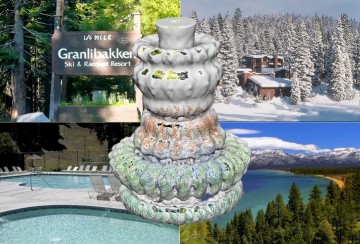By Julien Bergeron, PDF in Strynadka lab, CBR
Julien Bergeron, a Postdoctoral Fellow in Strynadka Lab at CBR, attended the Keystone Symposia Meeting on Hybrid Methods in Structural Biology held on March 4-8, 2015 at Tahoe City, California.
Attendance of this meeting was partly funded by the CBR PDF Travel Award.
 My postdoctoral research focuses on using a combination of X-ray crystallography, Nuclear Magnetic Resonance (NMR), Electron Microscopy (EM), and other biochemical and biological assays in order to propose an atomic model of the type III secretion system (T3SS), a large macromolecular nano-machine found in many pathogenic bacteria and responsible for the injection of toxins into target cells. Therefore the 2015 Keystone Symposium on Hybrid Methods in Structural Biology was an obvious choice of a conference. I had attended the previous edition of this meeting, in 2013, which had been invaluable for getting acquainted with approaches and ideas that other groups have been developing. Therefore, I had high expectations for this meeting, both in terms of identifying new potential techniques and/or collaborators for my own project, as well as gaining more attention for my research from the Structural Biology community.
My postdoctoral research focuses on using a combination of X-ray crystallography, Nuclear Magnetic Resonance (NMR), Electron Microscopy (EM), and other biochemical and biological assays in order to propose an atomic model of the type III secretion system (T3SS), a large macromolecular nano-machine found in many pathogenic bacteria and responsible for the injection of toxins into target cells. Therefore the 2015 Keystone Symposium on Hybrid Methods in Structural Biology was an obvious choice of a conference. I had attended the previous edition of this meeting, in 2013, which had been invaluable for getting acquainted with approaches and ideas that other groups have been developing. Therefore, I had high expectations for this meeting, both in terms of identifying new potential techniques and/or collaborators for my own project, as well as gaining more attention for my research from the Structural Biology community.
On both these aspects, the conference did not disappoint! Recent advances in using X-ray lasers and cryo-EM for structural characterization generated a lot of excitement from conference attendees. In particular, the use of these techniques to tackle the challenges presented by membrane-embedded complexes (such as the T3SS) appear to be leading towards a complete revolution in the Structural Biology field. On a more personal note, NMR is the technique that I enjoy using most, but it has been in relative decline in the past few years, as it is limited by the size of the proteins that can be studied. I was therefore particularly pleased to observe an apparent resurgence of NMR, which is being increasingly employed in combination with other techniques for structural studies of protein dynamics.
The conference was also a big success on the networking front. The attendance was limited to approximately 140 attendees, which I found significantly more manageable than larger conferences, as it was easy to find any scientist I wanted to talk with. The poster sessions were a particular highlight, both as an attendee and as a presenter. My poster generated a lot of interest, sustaining discussion with other researchers long after the session officially ended. As always, the open bar greatly helped to lubricate the conversation and flow of ideas. I remember vividly that at the end of the last poster session, Yfan Cheng (pioneer in using cryo-EM for structure determination, at UCSF) and Dorothee Kern (HHMI scholar and expert in studying enzymes kinetics by NMR, at Brandeis University) stayed for over an hour to discuss with younger scholars the future of Structural Biology, and reminiscing about growing up under Communist regimes in their respective countries of origin (China and East Germany). These rare moments of exchange with scientific luminaries are, in my opinion, what these conferences are really about, and are very inspirational for young scientists.
The environment of the Conference, held in Lake Tahoe (California) was visually impressive, although the cost of staying extra days, as well as of ski lift tickets, was largely prohibitive for the average post-doc. Of course I must concede that being located in Vancouver, the proximity of a ski resort was not as exciting to me as it was to most other attendees!


